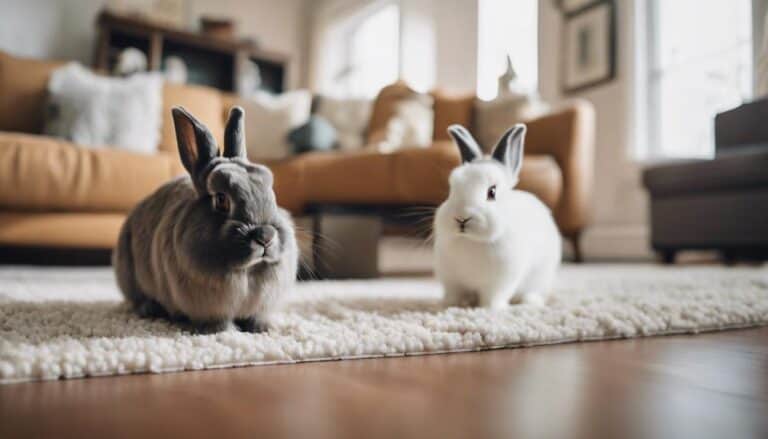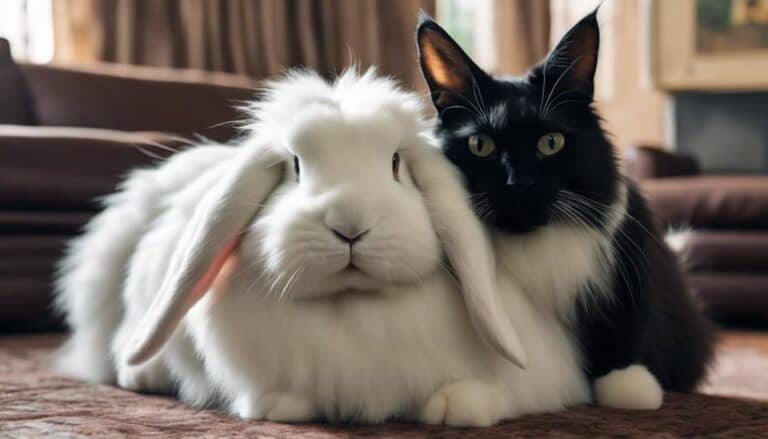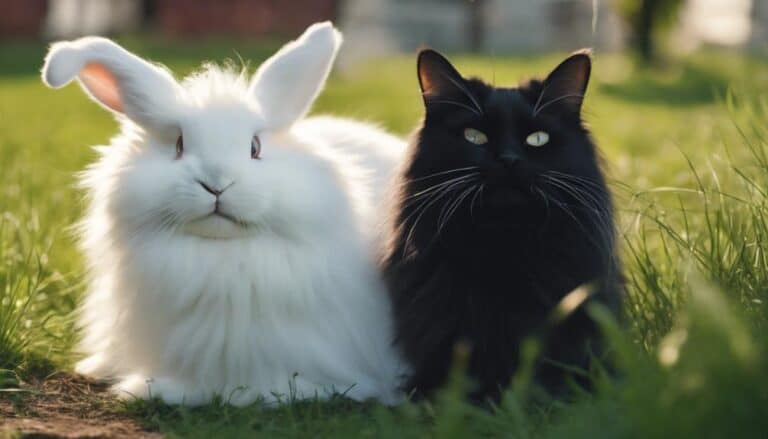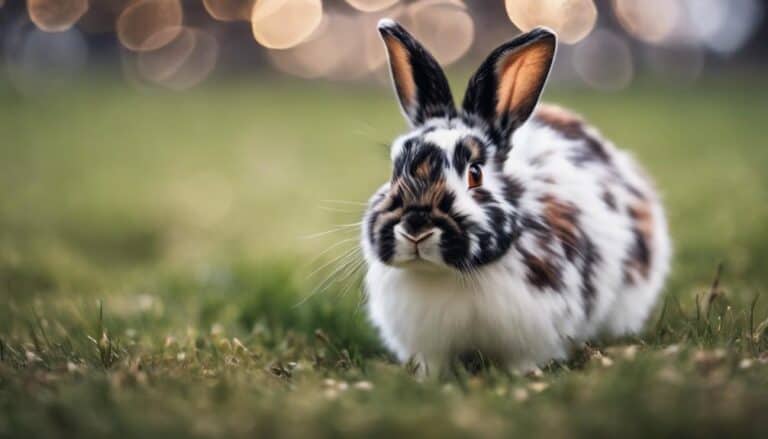In the winter, bunnies survive by burrowing in insulated dens and hiding under dense bushes and trees for warmth. They breed strategically, adjusting litter timing for food availability. Bunnies gather in groups for warmth and safety, hiding under decks and coops. They use snow trails to save energy and access food. Their unique winter physiology includes brown fat for heat and energy, along with a high metabolism. Bunnies adapt by changing their diet and seeking shelter in natural spots. Their innovative survival tactics help them thrive in the cold. Discover more about bunnies' winter strategies in the detailed research.
Contents
- 1 Key Takeaways
- 2 Winter Sheltering Tactics
- 3 Breeding Adaptations for Winter
- 4 Seeking Protective Shelter
- 5 Utilizing Snow Trails for Navigation
- 6 Unique Winter Physiology
- 7 Polygamous Mating Behavior
- 8 Brown Fat Production for Heat
- 9 Strategies for Winter Survival
- 10 Should I be worried about my pet rabbit’s stress levels during the winter months?
- 11 Conclusion
Key Takeaways
- Utilize insulated underground dens for warmth and protection
- Thick fur provides insulation against cold weather
- Conservation of body heat by huddling together
- Brown fat aids in heat generation and insulation
- Efficient navigation on established snow trails for energy conservation
Winter Sheltering Tactics
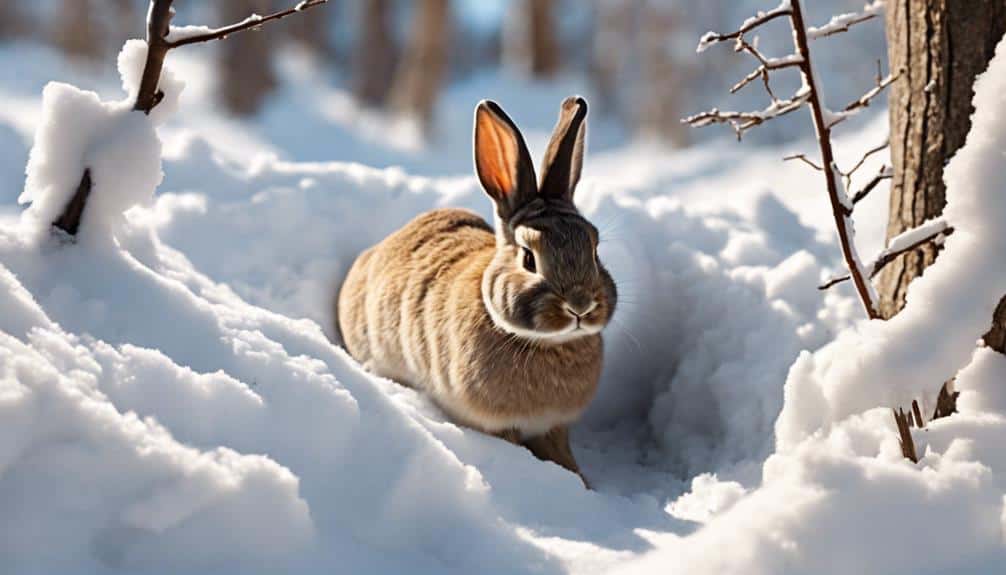
When winter arrives, cotton-tail rabbits employ various strategic tactics to guarantee their survival by seeking shelter in insulated underground dens. These rabbits, with their thick fur that provides insulation against the cold weather, are adept at finding secure hiding spots under thick bushes and evergreen trees to evade predators during the harsh winter months.
In addition to natural cover, rabbits also utilize solid fences and opaque structures as hiding places to stay safe and warm. They're known to frequent yards with good food sources and ample hiding spots to ensure their survival during winter.
When faced with severe weather conditions, cotton-tail rabbits seek refuge under woody vegetation, which not only shields them from the elements but also provides an extra layer of protection against predators. By employing these strategic winter sheltering tactics, cotton-tail rabbits increase their chances of surviving the challenging winter season.
Breeding Adaptations for Winter
When winter arrives, rabbits strategically time their reproductive efforts to guarantee survival. They carefully select nesting sites to safeguard their offspring from the harsh elements.
Winter Reproductive Timing
During winter, cottontail rabbits strategically time their breeding to guarantee the continuation of their species by adapting to the seasonal availability of resources. By having a second litter in early summer after the spring breeding season and possibly a third litter in September, rabbits show flexibility in breeding timing.
This winter breeding allows rabbits to secure the survival of their species by producing offspring during times of abundant resources despite the challenges posed by winter weather. By actively breeding in winter, rabbits can maintain their population numbers and genetic diversity, showcasing their adaptability and resilience in harsh environmental conditions.
This reproductive strategy highlights the evolutionary adaptions that enable cottontail rabbits to thrive even in the face of winter's challenges.
Nesting Site Selection
Have you ever wondered how cottontail rabbits strategically select nesting sites to secure the survival of their young during the harsh winter months?
Cottontails exhibit a keen sense of choosing locations with good insulation for breeding purposes. They often repurpose abandoned dens or seek shelter under decks to protect their offspring from the cold. Snow trails leading to these shelters serve as visible indicators of their frequent use during winter.
Unlike some animals that dig their own dens, cottontails rely on existing structures for breeding, emphasizing the importance of finding suitable shelter. Selecting safe and insulated nesting sites is vital for shielding newborn kits from the unforgiving winter elements, ensuring their chances of survival in the cold season.
Seeking Protective Shelter
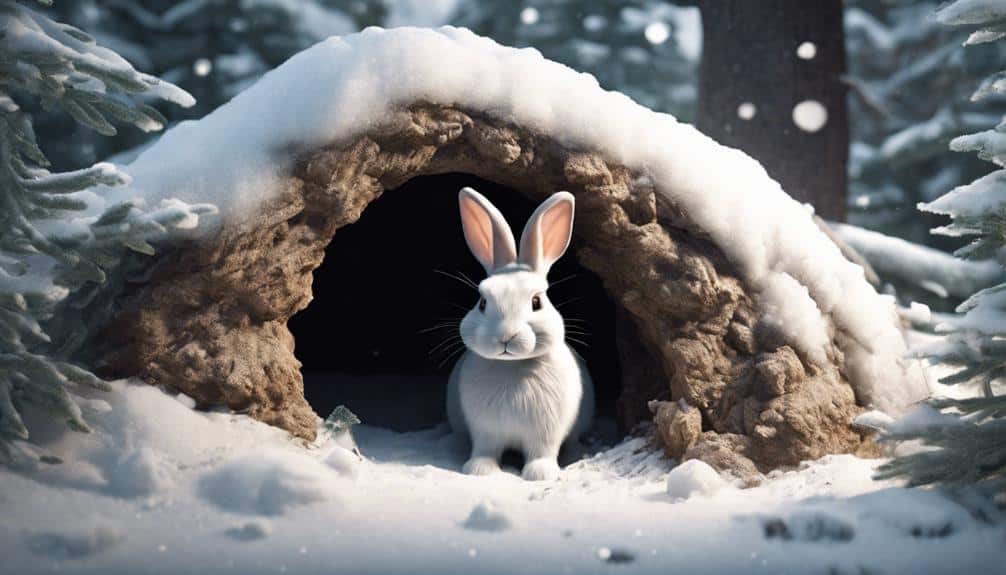
Seeking protective shelter in winter, rabbits strategically utilize insulated underground dens to keep warm and shelter themselves from the harsh environmental conditions. These dens provide a safe haven where rabbits can huddle together, conserving body heat and minimizing exposure to the cold. The burrows also offer protection from predators, as they're hidden from view beneath the ground.
Additionally, rabbits seek refuge under thick bushes, evergreen trees, solid fences, and opaque structures during winter. These natural and man-made shelters provide cover from both predators and inclement weather. Hiding under decks or coops is another common strategy employed by rabbits to shield themselves from the elements.
Traversing their winter landscape with precision and efficiency, rabbits utilize snow trails as familiar pathways for movement and resource access. Snow trails serve as essential tools for rabbits to conserve energy and navigate their snowy surroundings effectively. Here are some key observations about how rabbits utilize snow trails:
- Efficient Navigation: By following established snow trails, rabbits can move swiftly and with minimal effort, allowing them to reach their destinations more quickly.
- Energy Conservation: Utilizing snow trails helps rabbits conserve precious energy reserves by avoiding unnecessary detours and obstacles.
- Resource Access: These trails lead rabbits to food sources and shelter, ensuring they can meet their survival needs without wasting energy on aimless wandering.
- Trail Maintenance: Rabbits create snow trails through repeated use, packing down the snow and shaping pathways that facilitate easier movement.
- Winter Adaptation: Following snow trails is a strategic adaptation that enables rabbits to thrive in their winter environment by optimizing their movements and resource utilization.
Unique Winter Physiology
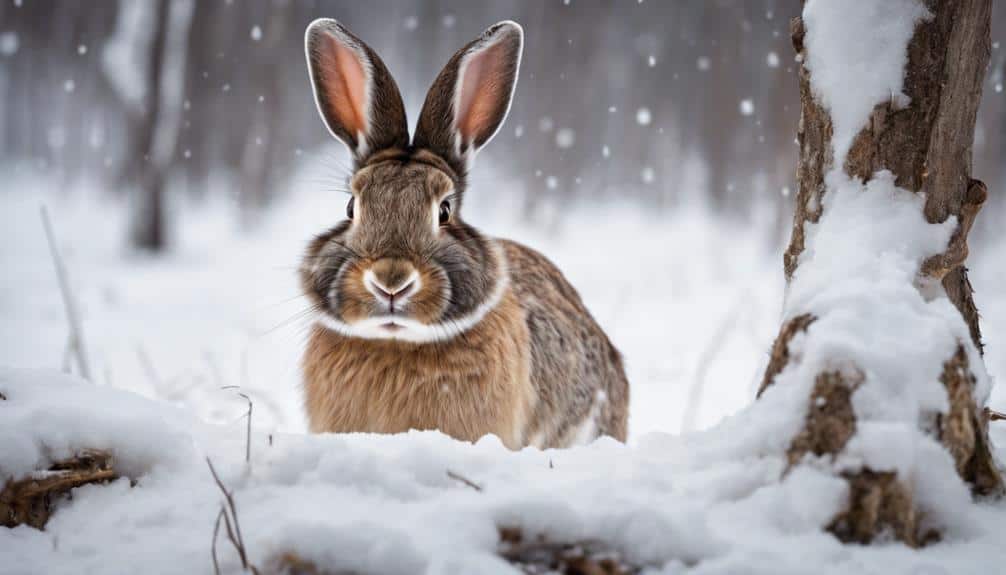
Traversing the snowy terrain with agility, rabbits' unique winter physiology equips them with specialized mechanisms for heat generation and energy conservation. Brown fat plays an essential role in this process by aiding in heat production through mitochondria and providing insulation for the rabbits. Additionally, the production of vitamin C in their liver not only serves as protection but also supports the function of brown fat, enhancing their ability to stay warm during the cold season. Rabbits' high metabolism is another key factor in their winter survival, as it allows them to efficiently utilize the energy stored in brown fat to maintain their body temperature. This combination of adaptations enables rabbits to shift from a summer diet of tender plants to the tougher twigs and bark available in winter, ensuring their survival through the harsh conditions.
| Physiological Feature | Role in Winter Survival |
|---|---|
| Brown Fat | Heat generation and insulation |
| Vitamin C Production | Protection and support for brown fat function |
| High Metabolism | Efficient energy utilization for warmth |
Polygamous Mating Behavior
During winter, rabbits engage in polygamous mating behavior to maximize their reproductive success and genetic diversity. This strategy involves males mating with multiple females, contributing to the rapid population growth of rabbits in suitable environments.
Here are some key points to understand about rabbits' polygamous mating behavior:
- Reproductive Success: By mating with multiple females, male rabbits increase their chances of securing their genes and producing more offspring.
- Genetic Diversity: Polygamous mating helps in creating genetic variability within the population, enhancing the overall adaptability and survival chances of the species.
- Multiple Litters: This behavior allows rabbits to have multiple litters throughout the breeding season, further increasing their reproductive output.
- Fertilization Assurance: Females may mate with different males to guarantee fertilization and genetic variability in their offspring.
- Population Growth: The polygamous mating behavior of rabbits plays a significant role in maintaining and expanding their populations in the wild.
Brown Fat Production for Heat
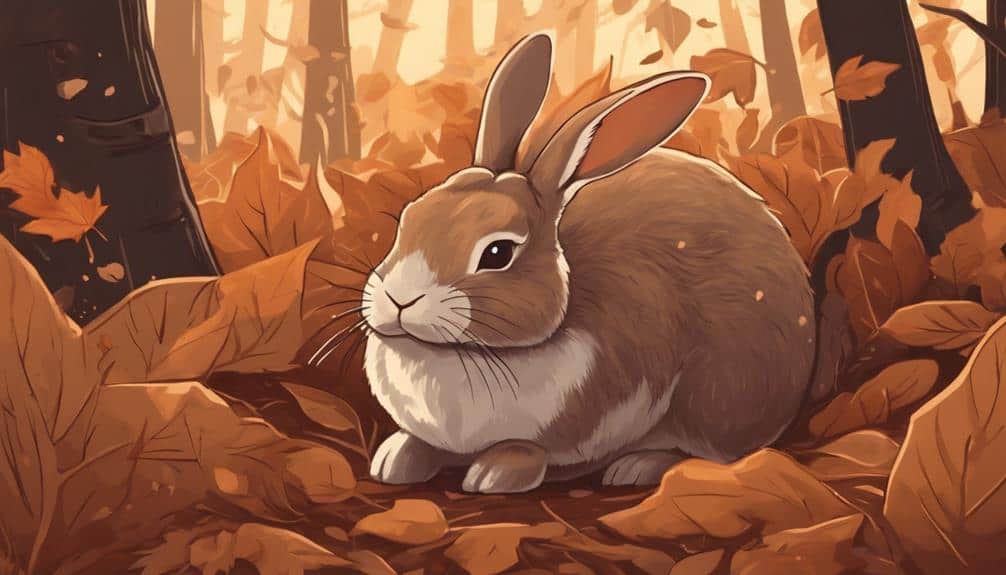
Brown fat, an essential component for heat generation in rabbits during winter, plays an important role in their survival strategy. This specialized type of fat is rich in mitochondria, which are responsible for producing heat through a process known as thermogenesis. Not only does brown fat help rabbits generate warmth, but it also provides critical insulation against the cold weather. Additionally, brown fat serves as a valuable energy source, allowing rabbits to maintain their body temperature and conserve energy during the harsh winter months. Vitamin C, produced in the liver, plays a significant role in supporting the function of brown fat in rabbits, further highlighting the importance of this adaptive mechanism for winter survival.
| Brown Fat Facts | |
|---|---|
| Heat Generation | Mitochondria activity |
| Insulation | Protection from cold |
| Energy Source | Fuel for warmth |
| Vitamin C Production | Liver function |
| Physiological Adaptation | Survival strategy |
Strategies for Winter Survival
Implementing survival tactics is crucial for rabbits to endure the harsh winter conditions and thrive in their natural habitat. During the winter, rabbits employ several strategies to guarantee their survival:
- Insulated Dens: Rabbits grow a thick fur coat and seek shelter in insulated underground dens to stay warm in extreme cold temperatures.
- Varied Diet: They actively search for less selective food sources like grass, ground plants, twigs, bark, and tree buds to sustain themselves when resources are scarce in winter.
- Camouflage: Rabbits adapt to winter predators by hiding in thick bushes, evergreen trees, solid fences, and opaque structures to avoid detection and stay safe.
- Constant Activity: Despite facing challenges like extreme cold and limited food sources, rabbits remain active year-round, creatively finding food and shelter even in the harshest winter conditions.
- Adaptability: Rabbits can withstand temperatures as low as 32 degrees by utilizing insulated dens, natural shelters, and their innate adaptability to endure the cold winter months successfully.
Should I be worried about my pet rabbit’s stress levels during the winter months?
During the winter months, it’s important to monitor your pet rabbit’s stress levels. Managing rabbit stress effectively can help prevent health issues. Ensure their environment is warm and cozy, with plenty of hiding spots. Providing stimulating toys and spending quality time with them can also help reduce their stress.
Conclusion
You have learned about the various strategies bunnies use to survive winter.
Did you know that bunnies can produce brown fat to stay warm during the cold months? This unique adaptation helps them conserve energy and maintain their body temperature.
By understanding these survival techniques, we gain a deeper appreciation for how these small creatures navigate the harsh winter conditions.
How fascinating it's to witness the resilience and resourcefulness of nature's creatures.

